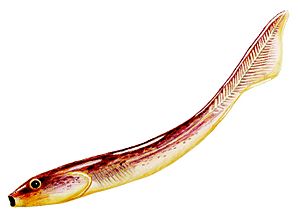Palaeospondylus facts for kids
Quick facts for kids Palaeospondylus |
|
|---|---|
 |
|
| Reconstruction of Palaeospondylus as an agnathan | |
| Scientific classification | |
| Kingdom: | |
| Phylum: | |
| Subphylum: | |
| Genus: |
Palaeospondylus
Traquair, 1890
|
| Species: |
P. gunni
|
| Binomial name | |
| Palaeospondylus gunni Traquair, 1890
|
|
Palaeospondylus was a small, ancient creature that looked a bit like a fish. It lived a very long time ago. Scientists know about it because they found its fossils in a place called the Achanarras slate quarry in Caithness, Scotland.
What Did Palaeospondylus Look Like?
When scientists find a fossil of Palaeospondylus, it often looks like a dark stain on a rock. This is because the animal's body turned into carbon over millions of years.
Palaeospondylus was shaped like an eel. It was quite small, growing up to about 6 centimeters (2.4 inches) long. That's roughly the length of your pinky finger!
Its head had a skull made of tough, rubbery material called cartilage. This is similar to what your nose or ears are made of. The skull had places for its nose and ears. It also had a part that looked like gills, which it would have used to breathe underwater. Scientists are still not sure if it had regular jaws like most fish.
Solving the Mystery of Palaeospondylus
Ever since Palaeospondylus was discovered in 1890, scientists have been puzzled about where it fits in the animal family tree. They call this puzzle its phylogeny. Many different ideas have been suggested over the years.
For a long time, no one was sure if it was a type of fish, an early amphibian, or something else entirely. Some thought it might be a baby lungfish. Others suggested it was a young tetrapod (an animal with four limbs).
Some scientists even thought it was a chimera, meaning it had features from different types of animals. It was also thought to be an agnathan (a jawless fish) or an early type of hagfish. In 2017, a study suggested it might be an early relative of sharks and rays.
New Discoveries About Palaeospondylus
In 2022, new research helped solve some of the mystery. Scientists used a special kind of X-ray machine called synchrotron radiation X-ray micro-computed tomography. This allowed them to see inside the tiny fossils without damaging them.
They studied the neurocranium, which is the part of the skull that protects the brain. They found that the neurocranium of Palaeospondylus was very similar to those of two ancient fish called Eusthenopteron and Panderichthys.
These two fish are known as "stem-tetrapods." This means they are very close relatives to the first animals that moved onto land. Based on this, the researchers believe Palaeospondylus fits right between Eusthenopteron and Panderichthys in the evolutionary timeline. This new finding helps us understand the journey of animals from water to land.

